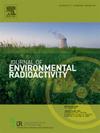U胁迫对向日葵幼苗生理耐受特性及矿质元素分布的影响
IF 2.1
3区 环境科学与生态学
Q3 ENVIRONMENTAL SCIENCES
引用次数: 0
摘要
植物矿质营养物质的代谢对植物的生长发育至关重要,是表征植物在各种环境下生长状态的关键参数。然而,放射性核素铀作为植物的非必需元素,极易在根系中积累,引起根系毒性和植物矿质养分代谢紊乱。以水培向日葵为试验材料,探讨了向日葵幼苗对铀的耐受特性,比较了向日葵不同根系成分和器官对矿质养分的吸收。结果表明,不同向日葵品种和向日葵各部位对铀的吸收和积累存在显著差异,铀处理对向日葵根组织造成严重损害。同时,铀主要积聚在根组织的细胞壁中,造成持续的损害。此外,抗氧化酶在防止铀胁迫损伤中起着至关重要的作用。铀胁迫破坏了向日葵的光合代谢。0.01 mM铀处理后,向日葵根部和叶片中大部分矿质元素含量均显著升高。铀处理显著降低了TY007和S668叶片Mg含量,分别降低11.03 ~ 77.68%和28.51 ~ 58.40%。本研究为修复城乡棕地铀污染提供了科学依据。本文章由计算机程序翻译,如有差异,请以英文原文为准。

Effects of U stress on physiological tolerance characteristics and mineral element distribution of sunflower seedlings
The metabolism of plant mineral nutrients is crucial for plant growth and development and is a key parameter for characterising the growth state of plants in various environments. However, as a non-essential element for plants, radionuclide uranium readily accumulates in the roots, causing root toxicity and metabolic disorders of plant mineral nutrients. We used hydroponic sunflowers as experimental materials to explore the uranium tolerance features of sunflower seedlings and to compare the absorption of mineral nutrients by different root components and organs of the sunflower. The results showed that the absorption and accumulation of uranium by different sunflower varieties and various parts of sunflowers differed significantly, and uranium treatment severely damaged the sunflower root tissue. Simultaneously, uranium predominantly accumulated in the cell walls of the root tissue, contributing to sustained damage. Furthermore, antioxidant enzymes play a vital role in preventing damage caused by uranium stress. Uranium stress disrupts the photosynthetic metabolism of sunflowers. The levels of most mineral elements in the roots and leaves of sunflowers increased significantly after treatment with 0.01 mM uranium. Uranium treatment significantly reduced the Mg content of TY007 and S668 leaves by 11.03–77.68 % and 28.51–58.40 %, respectively. This study offers a scientific basis for remediating uranium contamination in urban and rural brownfield sites.
求助全文
通过发布文献求助,成功后即可免费获取论文全文。
去求助
来源期刊

Journal of environmental radioactivity
环境科学-环境科学
CiteScore
4.70
自引率
13.00%
发文量
209
审稿时长
73 days
期刊介绍:
The Journal of Environmental Radioactivity provides a coherent international forum for publication of original research or review papers on any aspect of the occurrence of radioactivity in natural systems.
Relevant subject areas range from applications of environmental radionuclides as mechanistic or timescale tracers of natural processes to assessments of the radioecological or radiological effects of ambient radioactivity. Papers deal with naturally occurring nuclides or with those created and released by man through nuclear weapons manufacture and testing, energy production, fuel-cycle technology, etc. Reports on radioactivity in the oceans, sediments, rivers, lakes, groundwaters, soils, atmosphere and all divisions of the biosphere are welcomed, but these should not simply be of a monitoring nature unless the data are particularly innovative.
 求助内容:
求助内容: 应助结果提醒方式:
应助结果提醒方式:


